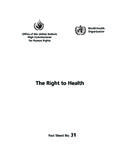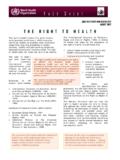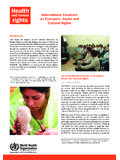Transcription of NUTRITION, EDUCATION AND AWARENESS …
1 Prepared bySerena Pepino FAO Right to Food Team Agricultural Development Economics Division (ESA) nutrition , EDUCATION AND AWARENESS RAISING FOR THE RIGHT TO ADEQUATE FOODTHEMATIC STUDY 6 The designations employed and the presentation of material in this information product do not imply the expression of any opinion whatsoever on the part of the Food and Agriculture Organization of the United Nations (FAO) concerning the legal or development status of any country, territory, city or area or of its authorities, or concerning the delimitation of its frontiers or boundaries.
2 The mention of specific companies or products of manufacturers, whether or not these have been patented, does not imply that these have been endorsed or recommended by FAO in preference to others of a similar nature that are not views expressed in this information product are those of the author(s) and do not necessarily reflect the views or policies of FAO. FAO, 2014 FAO encourages the use, reproduction and dissemination of material in this information product. Except where otherwise indicated, material may be copied, downloaded and printed for private study, research and teaching purposes, or for use in non-commercial products or services, provided that appropriate acknowledgement of FAO as the source and copyright holder is given and that FAO s endorsement of users views, products or services is not implied in any requests for translation and adaptation rights , and for resale and other commercial use rights should be made via or addressed to information products are available on the FAO website ( )
3 And can be purchased through STUDY 6 | iTable of Contentsiii Foreword iv Acknowledgmentv List of acronyms1 1. Introduction2 2. Analytical framework5 3. An overview of existing consensus for action in the global dialogue8 4. Operationalizing guidelines 10 and 11 for the right to adequate food 8 National Food Policy Plan of Action and Desirable Dietary Pattern (DDP): The People s Republic of Bangladesh 10 National School Feeding Programme: Brazil 11 School Feeding and Health Programme: El Salvador 13 Oportunidades Programme: Mexico 14 5.
4 Gaps and challenges in the implementation of guidelines 10 and 1119 6. Conclusions 20 Looking forward: Strengthening the right to adequate food underpinnings of future nutrition , EDUCATION and AWARENESS raising implementation21 ReferencesTHEMATIC STUDY 6 | iiiForeword To celebrate the 10th anniversary of the adoption of the Voluntary Guidelines to Support the progressive realization of the Right to Adequate Food in the Context of National Food Security (hereinafter Right to Food Guidelines ), the FAO Right to Food Team has prepared seven thematic studies that document and highlight progress made over the last ten years, while also capturing the challenges ahead in relation to major issues covered by the Right to Food Guidelines (RtFG).
5 The studies are helpful in reflecting upon current gaps and areas of improvement for future implementation of the guidelines and valuable for every person or organization that works in the context of national food security and is interested in realizing the right to adequate food by implementing the RtFG. The thematic studies1 cover the following topics:1. THE CURRENT STATUS OF THE RIGHT TO ADEQUATE FOOD IN FOOD SECURITY AND nutrition POLICY DESIGNSG uidelines 2, 3, 5, 6 and 13 2. INSTITUTIONAL FRAMEWORK FOR THE RIGHT TO ADEQUATE FOODG uidelines 5, 183.
6 LEGAL DEVELOPMENTS IN THE progressive realization OF THE RIGHT TO ADEQUATE FOOD Guidelines 74. NATURAL RESOURCES GOVERNANCE AND THE RIGHT TO ADEQUATE FOODG uideline 85. SOCIAL PROTECTION AND AN ENABLING ENVIRONMENT FOR THE RIGHT TO ADEQUATE FOOD Guidelines 8, 146. nutrition , EDUCATION AND AWARENESS RAISING FOR THE RIGHT TO ADEQUATE FOOD Guidelines 10, 117. INTERNATIONAL DIMENSIONS OF THE RIGHT TO ADEQUATE FOOD Guideline 19, Part III1 The views expressed in these thematic studies are those of the authors and do not necessarily reflect the views or policies of FAO.
7 The conclusions given are considered appropriate at the time of preparation. They may be modified in the light of further knowledge | nutrition , EDUCATION AND AWARENESS RAISING FOR THE RIGHT TO ADEQUATE FOODA cknowledgmentThis Thematic Study was prepared with the invaluable contribution and input from the nutrition Division (ESN), Development Law Service (LEGN) and the Right to Food Team of the Agricultural Development Economics Division (ESA) of FAO, under the lead authorship of Serena Pepino, Project Officer, Right to Food Team/ESA. The author would like to specially acknowledge the substantive contribution and guidance of Ellen Muehlhoff, Senior Officer/Group Leader, nutrition EDUCATION and Consumer AWARENESS Group, ESN.
8 The study has benefited from the comments and suggestions of Cristina Alvarez, Lalita Bhattacharjee, Ruth Charrondiere and Ramani Wijesinha Bettoni from the ESN, Margret Vidar and Yoon Jee Kim from the LEGN, and Juan Carlos Garc a y Cebolla, Simon Blondeau, Maarten Immink, Frank Mischler, and Sisay Yeshanew from the Right to Food team in ESA. A special thanks goes to Annamaria Ausania, Right to Food Consultant in ESA, who provided background research and content to the country case studies. The author wishes to thank Andrew Park, who edited the Thematic STUDY 6 | vList of acronymsCESCRC ommittee on Economic, Social and Cultural RightsCFSC ommittee on World Food SecurityDDPD esirable Dietary PatternEANE strategia Acci n Nutrici n ( nutrition Action Strategy)
9 ECLACE conomic Commission for Latin America and the CaribbeanEUEuropean UnionFAOFood and Agriculture Organizations of the United NationsFSNFood security and nutritionHRBAH uman rights -based approachGHIG lobal Hunger IndexGSFG lobal Strategic Framework for Food Security and NutritionICN2 Second International Conference on NutritionIFPRII nternational Food Policy Research InstituteIICAI nter-American Institute for Cooperation on AgricultureJFFLSJ unior Farmer Field and Life SchoolsOHCHRO ffice of the High Commissioner for Human RightsPASEP rograma de Alimentaci n y Salud Escolar (School Feeding and Health Programme)PNAEP rograma Nacional de Alimenta o Escolar (National School Feeding Programme)RtFGVoluntary Guidelines to Support the progressive realization of the Right to Adequate Food in the Context of National Food Security (Right to Food Guidelines)
10 SOFIThe State of Food InsecurityUNUnited NationsUNESCOU nited Nations Educational, Scientific and Cultural OrganizationUNSCNU nited Nations Standing Committee on NutritionUNSGU nited Nations Secretary-GeneralUNSRU nited Nations Special RapporteurWFPW orld Food ProgrammeWHOW orld Health OrganizationTHEMATIC STUDY 6 | 11. INTRODUCTIONThe Voluntary Guidelines to Support the progressive realization of the Right to Adequate Food in the Context of National Food Security (Right to Food Guidelines) provide practical guidance to states in their implementation of the progressive realization of the human right to adequate food.

















